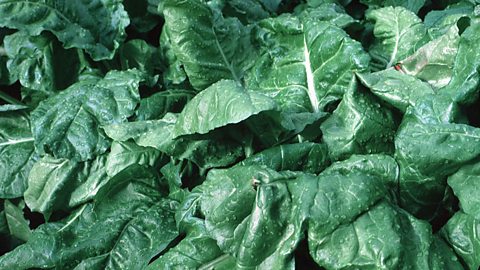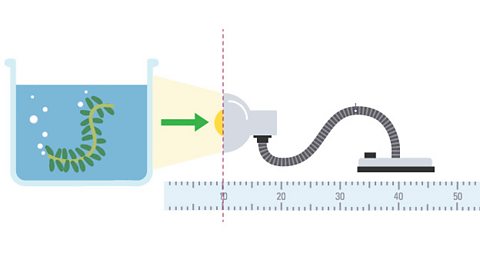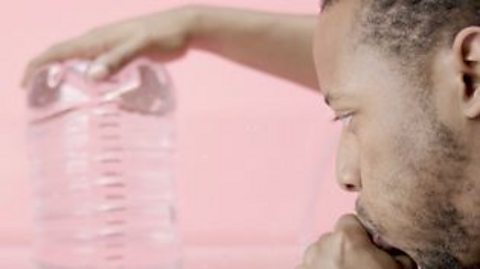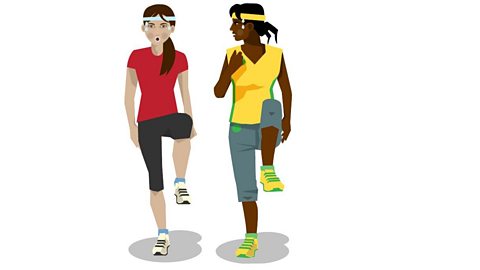Key points
A plantās rateHow quickly something happens. of photosynthesisA chemical reaction that occurs in the chloroplasts of plants in which the energy in light is stored in glucose. is affected by factors such as light intensity, the concentration of carbon dioxide and the temperature of its surroundings.
A limiting factorSomething that disrupts the growth or abundance of any organisms or population. is something that constrains the growth or abundance of any organisms or population.
Photosynthesis slows down or stops if the conditions arenāt sufficient enough.
Photosynthesis activity
Play this game to see how a seed or a plant is affected by changing how much water, sunlight and carbon dioxide it gets.
Video
Photosynthesis happens when light shines on leaves and both water and carbon dioxide are available. If we remove carbon dioxide, the reaction quickly slows and then stops. If we have light and carbon dioxide, but no water, there is still no reaction. Temperature also plays a part. If the temperature falls, the rate of photosynthesis will slow down. That's why grass grows very slowly, if at all, in winter. When water and carbon dioxide are reduced - like in hot, dry deserts - again the photosynthesis slows down.
Some plants have adapted to survive in these conditions, like cacti, which have spines instead of leaves to reduce water loss. When there is no light, at night-time for instance, photosynthesis stops completely. Farmers use lights to extend the growing cycle of vegetable plants, making sure we all have enough food to eat all year round.
So far, we've learnt that the main things that affect the rate of photosynthesis are light intensity, carbon dioxide concentration, temperature and water supply. These are also known as limiting factors. They can limit the rate of photosynthesis if it is in short supply.
OK, well I guess farmers can't control these limiting factors outside, can they?
That's why some farmers control the environment in a greenhouse. They can increase the rate of photosynthesis by increasing the limiting factors so crops can grow quicker and farmers can produce more in the same space of time. This means some farmers are no longer limited to being based rurally and have even started growing crops in cities.
So what sorts of crops do well from the higher rate of photosynthesis?
Well, a good example would be tomatoes and lettuce. Farmers in Iceland grow tomatoes in their greenhouses all year round, even when their daylight hours are very short, by using electricity from their geothermal renewables to provide both lighting and heating to their greenhouses. Incidentally, sometimes bees have to be sent there from mainland Europe for pollination, as it is just too cold in Iceland for the bees to be there naturally.
Wow, that's fascinating stuff, isn't it?
Famers can also add additional carbon dioxide into the greenhouse to increase the concentration, which then increases the rate of photosynthesis of the crops. This also benefits the environment, as rather than pumping waste carbon dioxide into the atmosphere as pollutants, farmers can redirect it into big greenhouses. Not only does this reduce their carbon footprint, it also gives them a profitable product.
Great stuff. So knowing about the rate of photosynthesis also helps the environment. That's amazing. How exactly do you measure the rate of photosynthesis, though.
Well, farmers usually use a handheld electronic device, but you could do this at home. All you need is pondweed.
Ok, how does that work?
You can work out the rate of photosynthesis of pondweed by counting the bubbles of oxygen being produced. The more bubbles, the higher the rate of photosynthesis.
Oh, that sounds pretty fun.
Can you answer these questions based on the video?
1. What happens to the growth rate of grass in winter?
2. How do farmers make photosynthesis happen at night?
It slows down because the temperature is low.
Lights are used to simulate the sun.
Limiting factors

The rate of photosynthesis may be limited by:
- Light intensity
- Low temperature
- Shortage of carbon dioxide concentration
- Water supply
- Low concentration of chlorophyllGreen pigment found within chloroplast that enables the process of photosynthesis to occur.
At any point, the rate of photosynthesis can be increased by adding:
- More light
- Heating towards optimum temperature
- More carbon dioxide
- More water
However, at a certain point the addition of more of these will not increase the rate of photosynthesis any further. This is because a second factor is limiting the rate of photosynthesis. Adding more of the rate-limiting factor will increase the rate further until another factor becomes limiting.

Light intensity
Low light intensity would slow down the rate of photosynthesis as light provides the energy for the process of photosynthesis. Even on sunny days, light may be limited to plants which are shaded by trees. Plants do not photosynthesise in the dark.
Temperature
If it is too cold, the rate of photosynthesis will decrease as the enzymes canāt work effectively. Equally plants cannot photosynthesise if it gets too hot as this causes their enzymes to denatureTo change the shape of an enzyme's active site, for example because of high temperatures or extremes of pH. Denatured enzymes no longer work. .
Carbon dioxide
If there is too little carbon dioxide, the rate of photosynthesis will slow down. Carbon dioxide may be limited in enclosed spaces. Plants can still run out of carbon dioxide in a greenhouse on a sunny day where there is plenty of light energy available.
Water supply
irrigationThe channelling of water from rivers and streams to fields in order to help crops grow. systems in greenhouses help to increase the production of plants. Farmers water plants outside too, especially when the climate is dry.
You won't see graphs for the effect of water on photosynthesis, as water is important in many other areas of a plant's life, not just photosynthesis.
Chlorophyll

Chlorophyll is a green pigment found in plants that traps light to allow photosynthesis to occur. Different plants have different concentrations of chlorophyll.
If there is too little chlorophyll this can limit the rate of photosynthesis.

Greenhouse conditions to maximise crop yield
Farmers try to get the maximum growth out of these crops by manipulating the conditions within their greenhouse.
Greenhouses are made out of glass to trap the sunās heat and increase the temperature to its optimum Best or most favourable conditions. to maximise photosynthesis.
Farmers sometimes use a paraffin heater to increase the temperature to its optimum level. This also pumps extra carbon dioxide in the greenhouse to increase the rate of photosynthesis and therefore increase the crop yieldThe amount of product obtained..
Greenhouses provide an enclosed space, reducing unwanted pests and pathogens that can harm crops.
Farmers add fertilisers which are full of minerals to help their crops grow.
They also sometimes use pesticides to kill unwanted pests that consume their crops.
Farmers must also balance out the cost of this against the yield of the crop to sustain a successful business.

Did you know?
To maintain greenhouse temperatures during cooler weather, water is heated to 85Ā°C and circulated throughout greenhouses.
An average hot water tank has a 158,500 gallon capacity. The average person uses 20 gallons of water per shower - therefore these greenhouse storage tanks could supply enough hot water for 7,925 showers.

Test your knowledge
Quiz
Test questions
List the different factors that can affect the rate of photosynthesis.
- Carbon dioxide concentration
- Light intensity
- Temperature
- Chlorophyll
- Water
Play the Atomic Labs game! gamePlay the Atomic Labs game!
Try out practical experiments in this KS3 science game.

More on Respiration and gas exchange
Find out more by working through a topic
- count12 of 13

- count13 of 13

- count2 of 13
